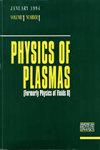Numerical investigations of spatiotemporal dynamics of space-charge limited collisional sheaths
IF 2.2
3区 物理与天体物理
Q3 PHYSICS, FLUIDS & PLASMAS
引用次数: 0
Abstract
Electrostatic particle-in-cell (PIC) and direct simulation Monte Carlo (DSMC) methods are used to compare the plasma dynamics of collisionless with collisional emissive sheaths in partially ionized environments. Space-charge limited emissive sheaths submersed in a plasma with a density of ∼1017 m−3 are examined using a PIC-DSMC solver, CHAOS. Collisionless emissive sheaths with plasma domains sufficiently long (30 and 60 Debye lengths, λD) are subject to strong oscillations due to two-stream electron instability, whereas emissive sheaths in weakly collisional conditions with a short domain (15 λD) exhibit self-spike (sawtooth) oscillations in the plasma field due to the trapped charge-exchange (CEX) ion population within the virtual cathode (VC) region. The two-stream electron instability leads to strong temporal fluctuations in the total emission current, with maximum deviations of 60% and 100% from the time-averaged current for the long plasma domains, whereas CEX collisions cause strong spikes in the emission current if the domain size is short. Our PIC-DSMC simulations show for the first time that the interaction of the two types of instabilities causes the strength of the self-spike to be weakened due to the strong fluctuations caused by the two-stream instability when a sufficiently long computational domain with ion-neutral collisions is employed. By conducting a two-dimensional Fast Fourier Transform (FFT) on the collisional and collisionless sheaths with long domains, we show that the transient evolution of CEX entrapment in the VC increases frequency of sheath oscillations up to two times the ion-acoustic frequencies observed in the collisionless sheath. CEX collisions weaken the VC region and result in a total emission current more than that obtained from the collisionless case for the same domain length. With a more rarefied neutral environment of 1019 m−3 in the plasma sheath, the total emission current increases only 4% in comparison with 14% for one order of magnitude denser environment, within 20 μs. In addition, the spike period is tested with different neutral temperatures and densities. While we do not observe any self-spike in the more rarefied environment, the spike period increased from 5 to 7.5 μs when the neutral temperature is increased from 300 to 2000 K in the denser environment with the simulation time of 20 μs.空间电荷受限碰撞鞘时空动力学的数值研究
使用静电粒子入室(PIC)和直接模拟蒙特卡洛(DSMC)方法比较了部分电离环境中无碰撞发射鞘和有碰撞发射鞘的等离子体动力学。使用 PIC-DSMC 求解器 CHAOS 对浸没在密度为 ∼1017 m-3 的等离子体中的空间电荷有限发射鞘进行了研究。等离子体域足够长(30 和 60 Debye 长度,λD)的无碰撞发射鞘会因双流电子不稳定性而产生强烈振荡,而等离子体域较短(15 λD)的弱碰撞条件下的发射鞘则会因虚拟阴极(VC)区域内的被困电荷交换(CEX)离子群而在等离子体场中表现出自尖峰(锯齿)振荡。双流电子的不稳定性导致总发射电流出现强烈的时间波动,对于长等离子体畴,最大偏差为时间平均电流的 60% 和 100%,而如果等离子体畴尺寸较短,CEX 碰撞则会导致发射电流出现强烈的尖峰。我们的 PIC-DSMC 模拟首次表明,当采用离子中性碰撞的计算域足够长时,两种不稳定性的相互作用会导致双流不稳定性引起的强烈波动,从而削弱自尖峰的强度。通过对具有长计算域的有碰撞鞘和无碰撞鞘进行二维快速傅里叶变换(FFT),我们发现在VC中CEX夹带的瞬态演化使鞘振荡频率增加到在无碰撞鞘中观察到的离子声频率的两倍。CEX 碰撞削弱了 VC 区域,导致在相同畴长度下的总发射电流大于无碰撞情况下的总发射电流。在等离子体鞘中 1019 m-3 的更稀疏中性环境下,20 μs 内的总发射电流仅增加了 4%,而在密度高一个数量级的环境下则增加了 14%。此外,我们还测试了不同中性温度和密度下的尖峰周期。虽然我们在更稀薄的环境中没有观察到任何自尖峰,但在模拟时间为 20 μs 的高密度环境中,当中性温度从 300 K 上升到 2000 K 时,尖峰周期从 5 μs 增加到 7.5 μs。
本文章由计算机程序翻译,如有差异,请以英文原文为准。
求助全文
约1分钟内获得全文
求助全文
来源期刊

Physics of Plasmas
物理-物理:流体与等离子体
CiteScore
4.10
自引率
22.70%
发文量
653
审稿时长
2.5 months
期刊介绍:
Physics of Plasmas (PoP), published by AIP Publishing in cooperation with the APS Division of Plasma Physics, is committed to the publication of original research in all areas of experimental and theoretical plasma physics. PoP publishes comprehensive and in-depth review manuscripts covering important areas of study and Special Topics highlighting new and cutting-edge developments in plasma physics. Every year a special issue publishes the invited and review papers from the most recent meeting of the APS Division of Plasma Physics. PoP covers a broad range of important research in this dynamic field, including:
-Basic plasma phenomena, waves, instabilities
-Nonlinear phenomena, turbulence, transport
-Magnetically confined plasmas, heating, confinement
-Inertially confined plasmas, high-energy density plasma science, warm dense matter
-Ionospheric, solar-system, and astrophysical plasmas
-Lasers, particle beams, accelerators, radiation generation
-Radiation emission, absorption, and transport
-Low-temperature plasmas, plasma applications, plasma sources, sheaths
-Dusty plasmas
 求助内容:
求助内容: 应助结果提醒方式:
应助结果提醒方式:


